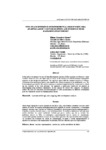Please use this identifier to cite or link to this item:
http://www.alice.cnptia.embrapa.br/alice/handle/doc/657613| Title: | Two-stage inference in experimental design using DEA: an application to intercropping and evidence from randomization theory. |
| Authors: | GOMES, E. G.  SOUZA, G. da S. e   VIVALDI, L. J.   |
| Affiliation: | Eliane Gonçalves Gomes, Embrapa-SGE; GERALDO DA SILVA E SOUZA, Embrapa-SGE; Lúcio José Vivaldi, Universidade de Brasília. |
| Date Issued: | 2008 |
| Citation: | Pesquisa Operacional, v.28, n.2, p. 339-354, mai./ago. 2008. |
| Description: | In this article we propose the use of Data Envelopment Analysis (DEA) measures of efficiency, under constant returns to scale and input equal to unity, in the analysis of multidimensional nonnegative responses in the design of experiments. The approach agrees with the standard Analysis of Variance (Covariance) for univariate responses and simplifies the statistical analysis in the multivariate case. The best treatments provided by the analysis optimize a combined output defined by shadow prices, which are the solutions of the DEA problem. The approach is particularly useful for the analysis of intercropping (crop mixtures) experiments. In this context we discuss two examples. To properly address the issue of correlation and non-normality of DEA measurements in different experimental plots we validate the results via Randomization Theory. |
| NAL Thesaurus: | experimental design intercropping |
| Keywords: | Ensaio experimental Consórcio Análise envoltória de dados Data envelopment analysis |
| Type of Material: | Artigo de periódico |
| Access: | openAccess |
| Appears in Collections: | Artigo em periódico indexado / Embrapa Unidades Centrais (AI-SEDE)  |
Files in This Item:
| File | Description | Size | Format | |
|---|---|---|---|---|
| Twostageinferenceinexperimental.pdf | 306,88 kB | Adobe PDF |  View/Open |









